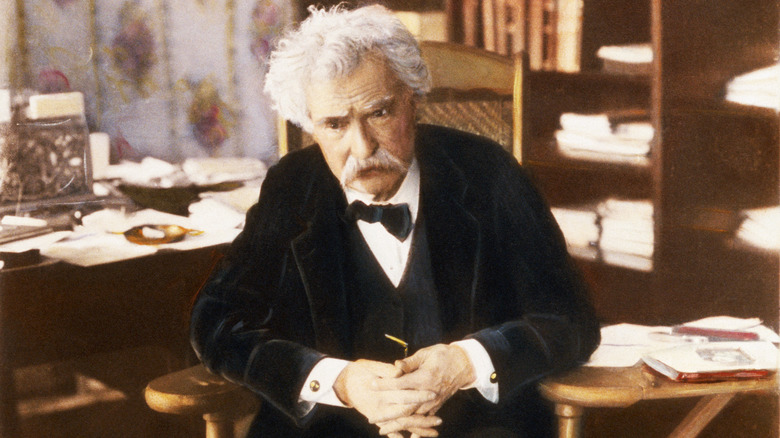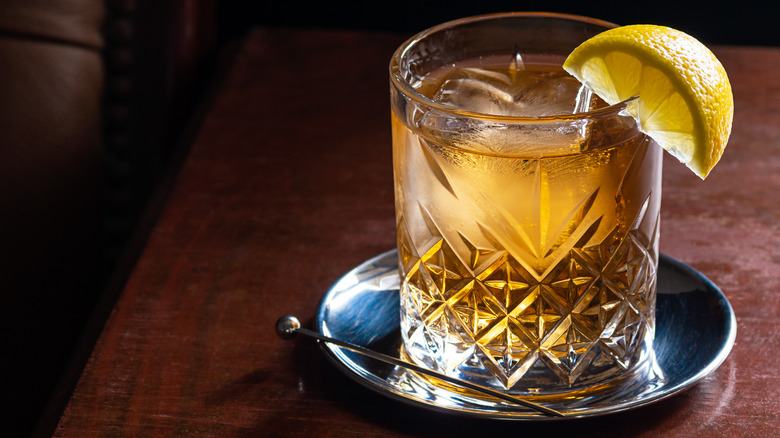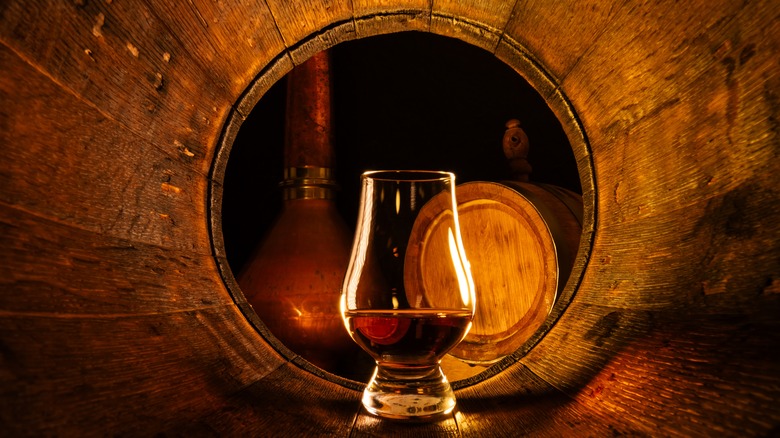Mark Twain's Favorite Whiskey Cocktail Was A Cherished Classic
We may receive a commission on purchases made from links.
Mark Twain is most famous for his novels, "The Adventures of Huckleberry Finn" and "The Adventures of Tom Sawyer," but the author was also renowned for his love of whiskey. This started out as an appreciation of bourbon but when Twain, from Missouri, traveled to England in the 1870s, he discovered Scotch — and also cocktails.
The discovery is documented in a letter Twain, whose real name was Samuel Langhorne Clemens, wrote to his wife Olivia in 1874. "Livy my darling, I want you to be sure & remember to have, in the bath-room, when I arrive, a bottle of Scotch whisky, a lemon, some crushed sugar, & a bottle of Angostura bitters," Twain wrote (per The New York Times).
Twain had been introduced to the drink, which he referred to as a "cock-tail" and was similar in style to an old fashioned, while on the ship SS City of Chester. And since his time in London, he had become so fond of the brown-colored whiskey mixed with his preferred ingredients that he admitted to drinking it three times a day – before his breakfast and evening meal, and before going to bed. He claimed it helped to aid his digestion.
Mark Twain's cocktail was similar to an old fashioned or whiskey sour
The old fashioned didn't get its name until the 1870s, but the history of whiskey cocktails goes back much further than this. While it is often made with American bourbon, Twain was enamored with Scotch whisky as opposed to whiskey for his cocktail of choice. And as he got older, Twain stuck to Scotch, which he drank on its own or mixed with a little hot water.
Traditionally, mixing an old fashioned sees the whiskey enhanced with a simple syrup or a sugar cube and some Angostura bitters, and it is often served with an orange twist. Mark Twain's preferred version combined the usual bitters and crushed sugar with the spirit but also incorporated a squeeze of fresh lemon juice. In this respect, it was rather like a whiskey sour without the egg white.
If you want to recreate Twain's whiskey cocktail, try using a ratio of three parts Scotch to one part lemon, which prevents the tart citrus from overpowering the other flavors in the drink. Add a cube of crushed sugar and a couple of dashes of bitters, to taste. We don't necessarily advise having one before breakfast, like Twain, though.
Other famous writers also love Scotch whisky
Whiskey and words go together like a classic cocktail recipe and lots of well-known authors, besides Mark Twain, have been fans of a good Scotch. Perhaps most famous was Scotland's national poet Robert Burns, who loved the country's national drink so much that it often appeared in his poems. His birthday is still celebrated every January with a dram of the spirit as part of a Burns night supper. And his legacy continues today with a Scotch named in his honor, available in both blended and single malt varieties.
Booker Prize winner Sir Kingsley Amis, who found fame with his first novel "Lucky Jim," was also partial to Scotch, and, in particular, single malts such as Macallan. "A Clockwork Orange" author Anthony Burgess liked to drink Scotch while writing. Truman Capote, author of "Breakfast at Tiffany's," was a fan of J&B Rare in the 1950s and 1960s — though he preferred to call it Justerini and Brooks. Poet and journalist Dorothy Parker's preferred tipple, meanwhile, was Haig & Haig Scotch.
Scotch whisky also plays a role in the life of more recent writers. The Japanese author of "Norwegian Wood," Haruki Murakami, is a fan of some of the peatiest Scotch whiskies from Islay, such as Laphroaig. And sometimes with authors, the spirit spills onto the page, too, such as Salander's shot of Lagavulin in Steig Larsson's "The Girl Who Kicked the Hornets' Nest," or Ian Rankin's detective John Rebus drinking Highland Park.



